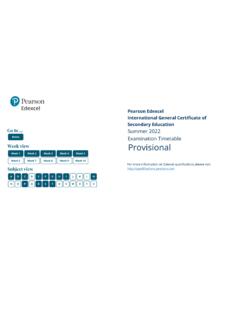Transcription of Vital Statistics Rapid Release - Centers for Disease ...
1 Vital Statistics Rapid ReleaseReport No. 012 May 2021 Births: provisional Data for 2020 Brady E. Hamilton, , Joyce A. Martin, , and Michelle Osterman, ,Division of Vital Statistics , National Center for Health Department of Health and Human Services Centers for Disease Control and Prevention National Center for Health Statistics National Vital Statistics System NCHS reports can be downloaded from: This report presents provisional 2020 data on births. Births are shown by age and race and Hispanic origin of mother. Data on cesarean delivery and preterm births also are Data are based on of all 2020 birth records received and processed by the National Center for Health Statistics as of February 11, 2021. Comparisons are made with final 2019 data and earlier The provisional number of births for the United States in 2020 was 3,605,201, down 4% from 2019.
2 The general fertility rate was births per 1,000 women aged 15 44, down 4% from 2019 to reach another record low for the United States. The total fertility rate was 1, births per 1,000 women in 2020, down 4% from 2019 to also reach another record low for the nation. In 2020, birth rates declined for women in all age groups 15 44 and were unchanged for adolescents aged 10 14 and women aged 45 49. The birth rate for teenagers aged 15 19 declined by 8% in 2020 to births per 1,000 females; rates declined for both younger (aged 15 17) and older (aged 18 19) teenagers. The cesarean delivery rate rose to in 2020; the low-risk cesarean delivery rate increased to The preterm birth rate declined to in 2020, the first decline in the rate since : birth rates maternal and infant health Vital Statistics National Vital Statistics SystemIntroductionThis report from the National Center for Health Statistics (NCHS) is part of the National Vital Statistics System Rapid Release Quarterly provisional Estimates.
3 This series provides timely Vital Statistics for public health surveillance based on provisional data received and processed by NCHS as of a specified date. Estimates (quarterly and 12-month period ending with each quarter) for selected key Vital Statistics indicators are presented and released online through Quarterly provisional Estimates ( ). The series also includes reports that provide additional information on specific topics to help readers understand and interpret provisional natality and mortality data. Also, now available are provisional birth estimates developed to monitor health services utilization and maternal and infant outcomes that may be directly or indirectly impacted by COVID-19. information is updated quarterly and is available from: provisional birth data for the 12 months of 2020 (1), this report supplements the Quarterly provisional Estimates for 2020 by presenting longer temporal trends in context and more detail (by race and Hispanic origin of the mother and by state of residence).
4 Statistics from previous provisional reports have been shown to be consistent with the final Statistics for the year (2,3). This report presents provisional data on births and birth rates and cesarean delivery and preterm birth rates for the United States in 2020. information on prenatal care, low birthweight, and other health utilization and maternal and infant risk factors is presented with final birth data for provisional estimates shown in this report are collected via the National Vital Statistics System (4). Findings are based on all birth records received and processed by NCHS for calendar year 2020 as of February 11, 2021; these records represent nearly 100% ( ) of registered births occurring in 2020. Comparisons in this report are based on the final data for 2019 and earlier years (3). Data for American Samoa, Guam, and the Virgin Islands were not available as of the Release of the 2020 provisional birth file.
5 Detailed information on reporting completeness and criteria may be found elsewhere (4,5).Hispanic origin and race are reported separately on the birth certificate. Data shown by Hispanic origin include all persons of Hispanic origin of any race. Data for non-Hispanic persons are shown separately for each single-race group. Data by race are based on the revised standards issued by the Office of Management and Budget (OMB) in 1997 (6). The race and Hispanic-origin groups shown are: non-Hispanic, single-race white; non-Hispanic, single-race black; non-Hispanic, single-race American Indian or Alaska Native (AIAN); non-Hispanic, single-race Asian; non-Hispanic, single-race Native Hawaiian or Other Pacific Islander (NHOPI); and Hispanic. For brevity, text references to race omit the term single-race (3). Department of Health and Human Services Centers for Disease Control and Prevention National Center for Health Statistics National Vital Statistics System2 Vital Statistics Surveillance ReportBirth and fertility rates for the United States and by maternal race and Hispanic origin for 2020 were based on population estimates derived from the 2010 census as of July 1, 2020 (7).
6 Changes and differences presented in this report are statistically significant at the level, unless noted otherwise. For information and discussion on computing rates and percentages and for detailed information on items presented in this report, see User Guide to the 2019 Natality Public Use File (4).Beginning with Quarterly provisional Estimates for Quarter 3, 2020, the use of record weights for provisional birth data was discontinued (1,5). This change was implemented because of the recent high levels of completeness of provisional birth data; the change in weighting had limited, if any, impact on the provisional birth estimates. Data shown in this report are based directly on the counts of all (unweighted) birth records received and processed by NCHS as of February 11, and birth ratesKey findings, illustrated in Tables 1 3 and Figures 1 and 2, s how: The provisional number of birthsfor the United States in 2020 was3,605,201, down 4% from the numberin 2019 (3,747,540) (Table s 1 3 andFigure 1).
7 This is the sixth consecutiveyear that the number of births hasdeclined after an increase in 2014,down an average of 2% per year, andthe lowest number of births since 1979(3,8,9). From 2019 to 2020, the provisionalnumber of births declined 3% forHispanic women, 4% for non-Hispanicwhite and non-Hispanic black women,6% for non-Hispanic AIAN women,and 8% for non-Hispanic Asian women(Table s 2 and 3). The 2% decline inthe number of births for non-HispanicNHOPI women was not significant. The provisional general fertility rate(GFR) for the United States in 2020was births per 1,000 women aged15 44, down 4% from the rate in 2019( ), another record low for the nation(Table s 1 and 2 and Figure 1) (3,8,9).From 2014 to 2020, the GFR declinedby an average of 2% per year. GFRs declined for each of therace and Hispanic-origin groupsfrom 2019 to 2020, down 3% fornon-Hispanic NHOPI women; 4% fornon-Hispanic white, non-Hispanicblack, and Hispanic women; 7% fornon-Hispanic AIAN women; and 9%for non-Hispanic Asian 2.
8 Birth rates for teenagers, by age of mother: United States, final 1991 2019 and provisional 2020 SOURCE: National Center for Health Statistics , National Vital Statistics System, per 1,000 females15 19 years15 17 years18 19 years05060708034519901995200020052010201 52020 Rate per 1,0 00 w omen aged 15 44 Number o f births (millions)NumberRateFigure 1. Number of live births and general fertility rates: United States, final 1990 2019 and provisional 2020 SOURCE: National Center for Health Statistics , National Vital Statistics System, Department of Health and Human Services Centers for Disease Control and Prevention National Center for Health Statistics National Vital Statistics System3 Vital Statistics Surveillance Report The provisional total fertility rate (TFR) for the United States in 2020 was 1, births per 1,000 women, down 4% from the rate in 2019 (1, ), another record low for the nation (3,9,10).
9 The TFR estimates the number of births that a hypothetical group of 1,000 women would have over their lifetimes, based on the age-specific birth rate in a given year. The TFR in 2020 was again below replacement the level at which a given generation can exactly replace itself (2,100 births per 1,000 women). The rate has generally been below replacement since 1971 and has consistently been below replacement since 2007 (3,8,9).Maternal age provisional birth rates declined for women in all age groups 15 44 from 2019 to 2020 and were unchanged for adolescents aged 10 14 and women aged 45 49 (Table 1). The provisional birth rate for teenagers in 2020 was births per 1,000 females aged 15 19, down 8% from 2019 ( ), reaching another record low for this age group (Table 1 and Figure 2) (3,8 10). The rate has declined by 63% since 2007 ( ), the most recent period of continued decline, and 75% since 1991, the most recent peak.
10 The rate declined an average of 7% annually from 2007 to 2020 (3,8). The number of births to females aged 15 19 was 157,548 in 2020 (Table 1), down 8% from 2019 (3,8 10). The provisional birth rates for teenagers aged 15 17 and 18 19 in 2020 were and births, respectively, down by 6% and 7% from 2019, again reaching record lows for both groups (3,8 10). From 2007 to 2020, the rates for teenagers aged 15 17 and 18 19 declined by 9% and 7% per year, respectively (3,8). The provisional birth rate for females aged 10 14 was births per 1,000 in 2020, unchanged since 2015. The provisional birth rate for women aged 20 24 in 2020 was births per 1,000 women, down 6% from 2019 ( ), reaching yet another record low for this age group (Table 1) (3,8,9). This rate has declined by 40% since 2007. The number of births to women in their early 20s also declined by 6% from 2019 to 2020 (Table 1).

















